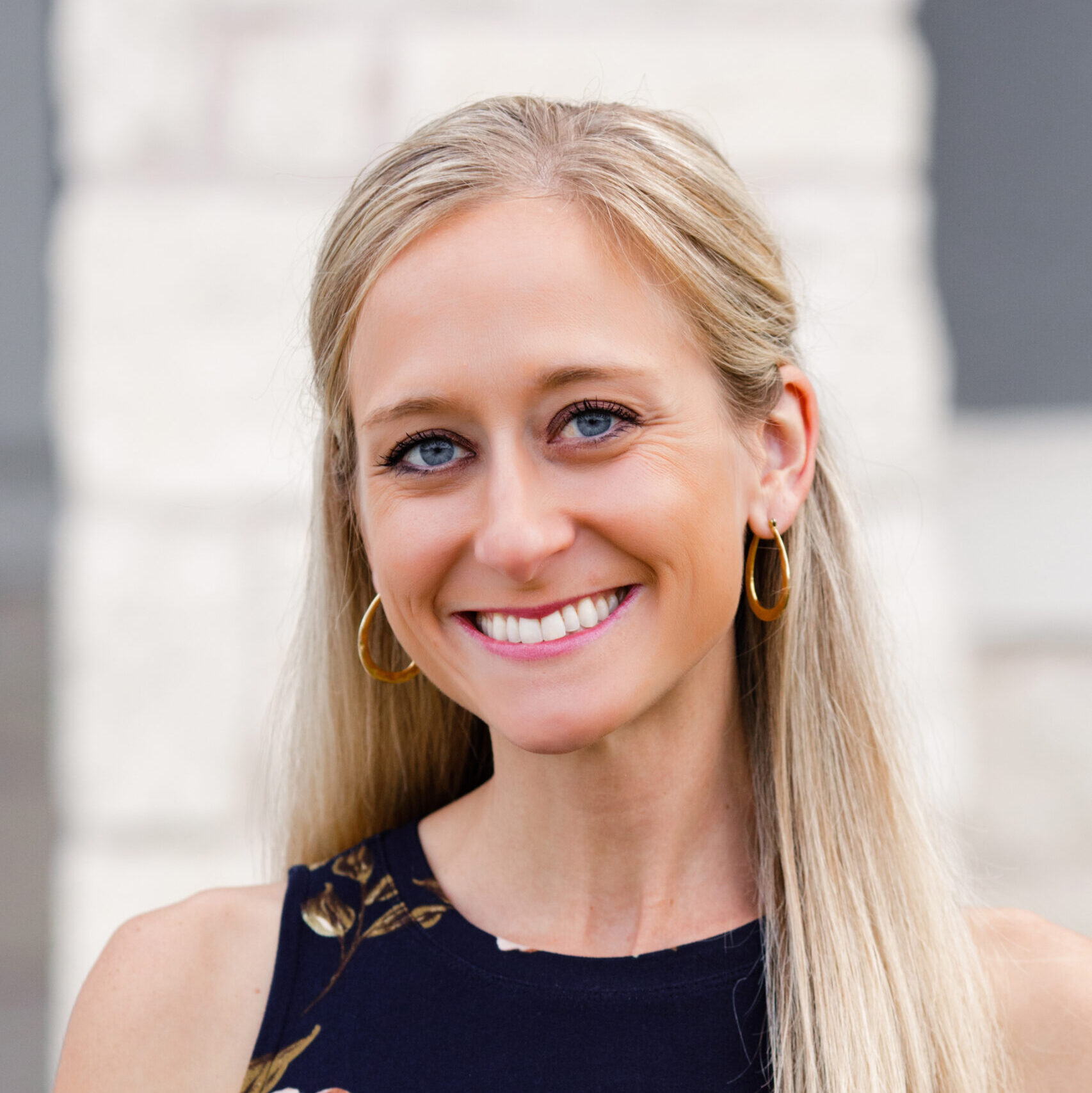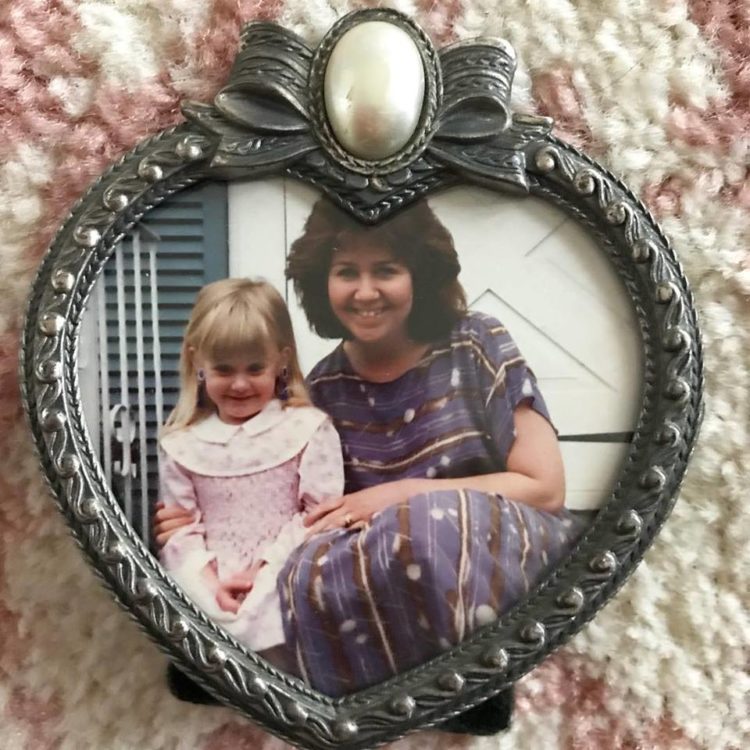
Mallary Tenore with her mother circa 1988. Robin Jo Tenore died when Mallary was 11.
How could I carve out the time to write a book when I was juggling so many other deadlines? How would I go about finding the book’s focus, its through-line, its structure? And would anyone outside of my immediate family and close friends care enough to want to read it?
It wasn’t until the summer of 2019, after enrolling in Goucher College’s Master’s of Fine Arts program in nonfiction writing, that I started to make meaningful progress on my memoir. The program gave me the support and structure I craved and the deadlines I needed. I’m now about 55,000 words into a memoir about my anorexia as a child and my present-day reality as a mother; I am tracing my journey as someone who is well along in recovery but who still lives with the imprints of an eating disorder. The book explores the idea that recovery is a spectrum, with sickness on one side and full recovery on the other. The space in between is what I like to call the middle place — that spot we may find ourselves in when we’re no longer acutely sick but not yet fully recovered.
To do that, I’ve had to revisit places that were pivotal to my past, reinhabit my younger self and, of course, make the time to write. I’ve also had to do a substantial amount of reporting, interviewing family members, my former medical and treatment providers, academic researchers and others who have struggled with eating disorders. The biggest challenge has been interviewing and writing about family — not because they’re unwilling to talk but because I find myself wanting to protect them the most.
To write a memoir is to accept that you are writing not just about your own life but about the people in it — the ones who love you, the ones who hurt you and the ones who both loved and hurt you. It’s an exercise in recognizing that you are going to have to tackle difficult questions, not just during the interview process but while navigating the complexities of what to include and what to leave out.
Along the way, I developed some tips for interviewing family members and deciding whether the material from your interviews should appear in your book.
Tips to keep in mind when interviewing family members
First, write what you believe to be true. In journalism, we’re often taught to report before we write. But in memoir writing, I’ve found that it’s helpful to write what I believe to be true before interviewing family members. There are a couple of reasons why. For one, it forces me to write down what I remember about a particular memory or experience. Sometimes a relative recounts the same event or time in a way that validates my own perspective; other times, their memories conflict with mine, causing me to doubt myself or blend memories together. Writing my own memories first allows me to commit my truth to paper. It also helps me identify if there are gaps in my memory that I need help filling, or details that seem fuzzy. That helps guide my reporting as I go forward.
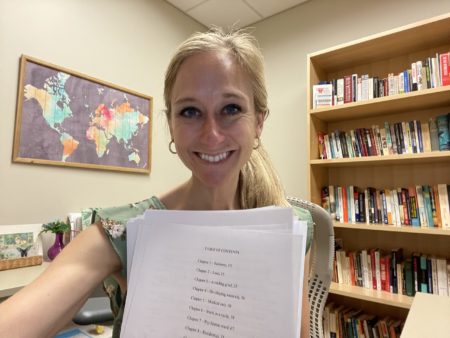
Mallary Tenore Tarpley with her thesis — a memoir in progress — from the MFA program at Goucher College.
Create a mission statement for your interview. My friend and former colleague Roy Peter Clark, a senior scholar at The Poynter Institute, encourages writers to draft mission statements for their stories. I adapted that to write mission statements for family interviews. That helps me to establish a focus for the interviews and stay focused on what I’m trying to achieve. Examples of an interview mission statement could be: “I want to ask the hard questions, even if it makes me and my family members uncomfortable. Having answers to these questions will help me connect some important dots in my story.” Or, “I want to get at a deeper level of detail, with an eye toward the five senses. I want to know how my sister felt, what she saw, what she heard, what she was wearing, when we learned that our mother had died. These details will enrich my writing and help transport readers back to that moment in time.”
Consider where and how you want to conduct the interview. My father lives 1,970 miles away from me, so in-person interviews are few and far between. When we are together, we have our best conversations while driving. My dad is a car guy, and he always seems at ease when behind the wheel. When we talk side-by-side in the car, our eyes are usually fixed on the road but our thoughts are turned inward. The “interview” feels more like a conversation. My father also is good at expressing himself in writing, so I often email him questions first, read his written responses and then call to clarify details and ask follow-up questions. Find the format and setting that work best for the person you’re interviewing and be open to making adjustments as you go. Also consider: How willing are you to step outside your own comfort zone in order to make your source feel more comfortable?
Be transparent about what you hope to get out of the conversation. I like to let family members know what I want to talk with them about and why I think their perspective is important. This helps set expectations, which can be especially helpful for family members who have never been interviewed. I also ask family members permission to record our interviews so that I can listen back on the recordings when writing. (Side note: I use a transcription service called Otter to record my interviews, and then keep track of the recordings in my memoir reporting log. Here’s the basic template I use.) I also try to gauge if my family members are comfortable with the possibility of appearing in the book and offer to share relevant passages with them prior to publication. Some memoirists avoid this out of fear that their relatives would try to dictate what they write, but I’ve decided to do it so that there aren’t any surprises.
Start with informational questions. I usually begin family interviews (and most of my interviews for that matter) with questions that revolve around facts. These include questions like: How old were you when….? What year did you…? Where were you when…? From there, I build up to the harder questions, like: Why did you feel the need to…? How did you react when…? Why didn’t you…? Do you regret…? I find that I’m more comfortable asking the tough questions, and family members are more open to answering them, if I’ve worked up to them.
Four factors to consider when deciding whether to write about a family member
Just because you’ve interviewed family members doesn’t mean you have to include every one of them in your memoir. Deciding whether and how to include them requires careful thought. Cheryl Strayed, author of the memoir “Wild,” once wrote: “Sometimes no matter how generous or forgiving or self-implicating you are, you have to write something awful about another person because that something awful is true.” I agree, and yet I encourage memoirists to consider a range of factors when making that decision. I’ve outlined them here:
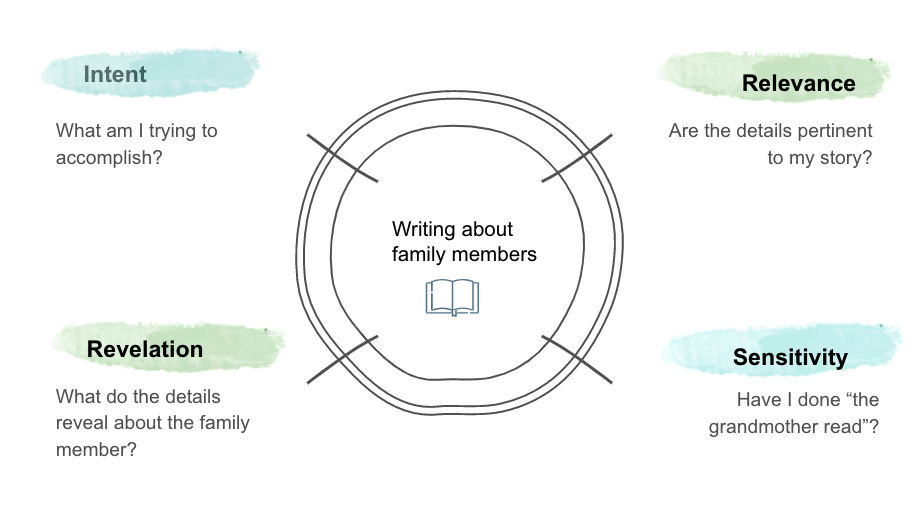
Cycle of relevancy (Courtesy of Mallary Tenore Tarpley)
Intent: What are you trying to accomplish? Ask yourself why you feel compelled to include certain family members in your memoir. Along the same lines, consider whether there’s anyone who you’re not including but should. I always knew that my mother would play a central role in my memoir, since her death, when I was 11, sparked the eating disorder that took grip a year later. But it wasn’t until I started delving deeper into my memoir writing that I realized how big of a role my father would need to play. Without him, my memoir would be incomplete. Remember that your memoir is ultimately about you, so every person you include should be in service of your story. And your intentions for inclusion should be clear. You never want to write about a family member merely out of spite or anger or blame. When you find yourself doing this, try journaling instead. It won’t fix everything, but it helps.
Relevance: Are the details pertinent to your story? For a while I struggled with knowing whether to include parts of my mother’s story in my memoir. I’ve learned a lot about her while interviewing other family members, and I’ve obtained some fun details — like when my 94-year-old maternal grandmother told me that my mom’s favorite perfume was Halston. I can still remember the smell of my mother’s perfume but I never knew what kind it was, so learning it was Halston felt like striking literary gold. Other details have been revelatory but not relevant, so I’ve left them out. I’m also mindful of the fact that I can’t ask my mom to confirm the details I’ve obtained during interviews. I don’t feel comfortable including information that I don’t remember and can’t easily verify.
Revelation: What does your reporting reveal about your family member? And would you feel comfortable sharing these details with a broader audience? These questions carry even more weight when writing about family secrets and fraught family relationships. As the writer Dinty Moore once said: “I believe more people have been harmed over time by secrets and concealment than by candor and revelation.” I agree but I’m also sensitive to the repercussions of revelation. Every reveal carries risk, and as a memoirist you have to decide if it’s a risk worth taking. You also need to consider the rate of revelation. Sometimes you may need to work your way up to a reveal by trailing out bread crumbs of context; other times, you may want to make a big revelation early on to create suspense or foreshadowing. The details you end up including should serve three key purposes: Enable readers to get to know the person you’re describing; illustrate the ways in which this person’s behaviors, words, and/or decisions affected you; and help readers see this person — the physical attributes and mannerisms that bring them to life on the page.
Sensitivity: Have you done “the grandmother read?” Think about whose opinion really matters to you and keep them in mind when writing about family. For me, this person is my grandma. Whenever I write about a family member (especially my mother), I read the passages out loud and picture my grandmother listening beside me. She’s one of my toughest readers and she’s not afraid to tell me when something sounds off or unaligned with her own recollections. When I picture her listening, it prompts me to make my writing as polished as possible. Years ago, my grandmother used to tell me that I needed to “leave the past in the past;” she didn’t understand why I felt compelled to write a memoir. But over the years, as she’s read my personal essays and seen me grow as a person and writer, her perspective has changed. What you’re doing with this book is so important, she recently told me. You’re helping to keep my daughter’s memory alive. She has not only become a constructive reader but a supportive one.
Tips to keep in mind while writing about family members
Writing about family is messy. There’s a temptation to want to clean up the mess before readers arrive at the page or to pretend it was never there in the first place. But it’s in the mess that we find meaning. As memoirists we need to be willing to write into the mess and then guide our readers through it. Some guiding tips:
Ditch the rose-colored glasses. For years when writing about my mother, I mythologized her. I portrayed her as the perfect mom, flawless in every way. But over time, these depictions seemed disingenuous. It was as though I was turning my mother into a one-dimensional stick figure. I came to see value in acknowledging what Lane DeGregory calls “the bruise on the apple.” Amid every apple’s shine, there is usually a bruise, a wormhole, a blemish to be found. When I first started to write about my mother’s blemishes, I felt I was betraying her memory. But in fact I was honoring her complexity. By writing about her flaws, I was able to confront how they impacted me as a child and the woman I’ve become.
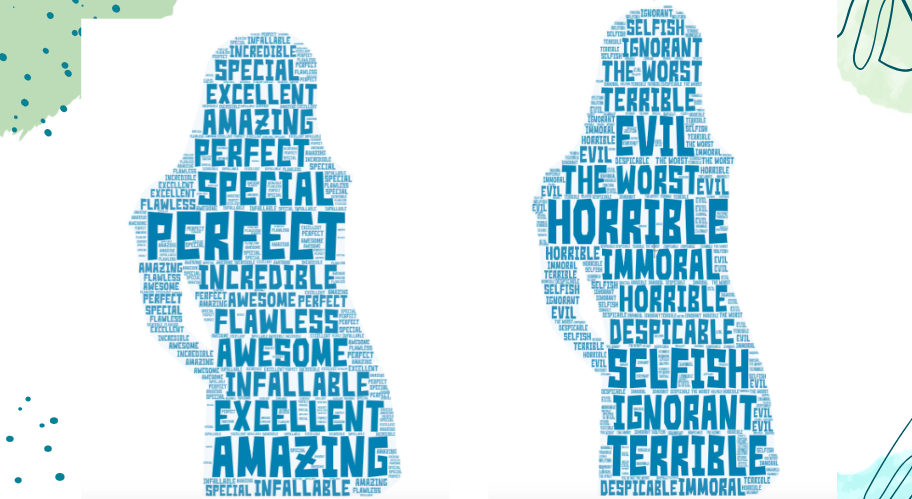 Resist the temptation to mythologize or demonize family members. (Courtesy of Mallary Tenore Tarpley)
Resist the temptation to mythologize or demonize family members. (Courtesy of Mallary Tenore Tarpley)
Determine how you’ll deal with conflicting memories. When interviewing family members, you likely will hear different sides of the same story. This presents a challenge: Do you write what you believe to be true? Do you leave out that part of the story? Or do you acknowledge the different views of the same story? Mary Karr does the latter in her book “The Liar’s Club,” something I find refreshingly transparent. I tend to stay true to my own memories; if the difference in recollection is startling enough, I’ll acknowledge it.
Strive for specificity. In an essay I wrote several years ago, I wrote that my mother “wasn’t well-educated.” I was merely alluding to the fact that my mom went to a vocational high school and never attended college. To my surprise, my grandmother took offense to that description. She said my mother was well-educated and consistently made the honor roll. Gram was right; my writing wasn’t as accurate as it could have been. Her critique reminded me that words can have unintended consequences. We know what we mean, but have we communicated that clearly enough to readers. It’s important, then, to challenge long-held assumptions and recognize when our writing falls short of the precision required by the truth. I now strive for greater specificity, looking for holes I can patch before my family points them out. “Wasn’t well-educated” becomes “went to vocational school and didn’t go to college.” It’s truer.
Write in the second person. If you feel stuck while writing about a family member, try writing in the second person. Kiese Laymon does this beautifully in his memoir “Heavy.” It reads like an epistolary memoir; it feels as if you’re listening to Laymon speak directly to his mother. I’m not suggesting you write your whole book this way, but sometimes drafting a chapter, or page, or paragraph in the second person can help you reflect on what you’re trying to say from a different vantage point. Once you’ve experimented with this, you can shift back to the appropriate perspective for your book.
Remember that writing can be therapeutic, but it’s not therapy. I’ve heard a couple of people say this, including one of my grad school professors, and it has always resonated with me. Sometimes you just need to write your way through something in order to process and make sense of it. When this is the case, journaling helps. So does therapy. I always knew that writing a memoir would be taxing — from both a writing and emotional standpoint. And I knew that to do my story justice, I would need to spend a lot of time resurfacing aspects of my eating disorder that I had long tried to forget. With this in mind, I decided early on to start seeing a therapist. That’s helped me stick with the memoir even during difficult stretches.
Hard work — and satisfaction
Memoir writing is not an easy lift. I’ve spent the last year working on my proposal and doing more reporting and writing in service of both the proposal and the book. I’ve done all of this knowing there are never any guarantees of publication.
A memoir also takes a willingness to revisit uncomfortable memories, and the ability to discern when and how to write about yourself and family. But once you move that memoir off the back burner, chances are you’ll be glad you did.
***


